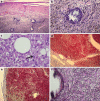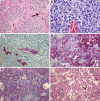Improved discrimination of melanotic schwannoma from melanocytic lesions by combined morphological and GNAQ mutational analysis
- PMID: 20865267
- PMCID: PMC2991233
- DOI: 10.1007/s00401-010-0749-z
Improved discrimination of melanotic schwannoma from melanocytic lesions by combined morphological and GNAQ mutational analysis
Abstract
The histological differential diagnosis between melanotic schwannoma, primary leptomeningeal melanocytic lesions and cellular blue nevus can be challenging. Correct diagnosis of melanotic schwannoma is important to select patients who need clinical evaluation for possible association with Carney complex. Recently, we described the presence of activating codon 209 mutations in the GNAQ gene in primary leptomeningeal melanocytic lesions. Identical codon 209 mutations have been described in blue nevi. The aims of the present study were to (1) perform a histological review of a series of lesions (initially) diagnosed as melanotic schwannoma and analyze them for GNAQ mutations, and (2) test the diagnostic value of GNAQ mutational analysis in the differential diagnosis with leptomeningeal melanocytic lesions. We retrieved 25 cases that were initially diagnosed as melanotic schwannoma. All cases were reviewed using established criteria and analyzed for GNAQ codon 209 mutations. After review, nine cases were classified as melanotic schwannoma. GNAQ mutations were absent in these nine cases. The remaining cases were reclassified as conventional schwannoma (n = 9), melanocytoma (n = 4), blue nevus (n = 1) and lesions that could not be classified with certainty as melanotic schwannoma or melanocytoma (n = 2). GNAQ codon 209 mutations were present in 3/4 melanocytomas and the blue nevus. Including results from our previous study in leptomeningeal melanocytic lesions, GNAQ mutations were highly specific (100%) for leptomeningeal melanocytic lesions compared to melanotic schwannoma (sensitivity 43%). We conclude that a detailed analysis of morphology combined with GNAQ mutational analysis can aid in the differential diagnosis of melanotic schwannoma with leptomeningeal melanocytic lesions.
Figures



Similar articles
-
Somatic mutations in GNAQ in amelanotic/hypomelanotic blue nevi.Hum Pathol. 2011 Jan;42(1):136-40. doi: 10.1016/j.humpath.2010.05.027. Epub 2010 Nov 5. Hum Pathol. 2011. PMID: 21056896
-
SF3B1 and BAP1 mutations in blue nevus-like melanoma.Mod Pathol. 2017 Jul;30(7):928-939. doi: 10.1038/modpathol.2017.23. Epub 2017 Apr 14. Mod Pathol. 2017. PMID: 28409567 Free PMC article.
-
Melanomas Associated With Blue Nevi or Mimicking Cellular Blue Nevi: Clinical, Pathologic, and Molecular Study of 11 Cases Displaying a High Frequency of GNA11 Mutations, BAP1 Expression Loss, and a Predilection for the Scalp.Am J Surg Pathol. 2016 Mar;40(3):368-77. doi: 10.1097/PAS.0000000000000568. Am J Surg Pathol. 2016. PMID: 26645730
-
Agminated blue nevus with a GNAQ mutation: A case report and review of the literature.J Cutan Pathol. 2019 Feb;46(2):130-133. doi: 10.1111/cup.13373. Epub 2018 Nov 19. J Cutan Pathol. 2019. PMID: 30315589 Review.
-
Blue nevi and variants: an update.Arch Pathol Lab Med. 2011 Mar;135(3):327-36. doi: 10.5858/2009-0733-RA.1. Arch Pathol Lab Med. 2011. PMID: 21366456 Review.
Cited by
-
How Should We Treat Meningeal Melanocytoma? A Retrospective Analysis of Potential Treatment Strategies.Cancers (Basel). 2022 Nov 27;14(23):5851. doi: 10.3390/cancers14235851. Cancers (Basel). 2022. PMID: 36497333 Free PMC article.
-
Primary pigmented meningeal melanocytoma originating in Meckel cave in a patient with carney complex: A case report.Medicine (Baltimore). 2020 Jan;99(3):e18783. doi: 10.1097/MD.0000000000018783. Medicine (Baltimore). 2020. PMID: 32011473 Free PMC article.
-
Diagnosing a Primary Leptomeningeal Melanoma by Gene Mutation Signature.J Invest Dermatol. 2016 Jul;136(7):1526-1528. doi: 10.1016/j.jid.2016.03.031. Epub 2016 Apr 7. J Invest Dermatol. 2016. PMID: 27060446 Free PMC article. No abstract available.
-
Malignant Melanotic Nerve Sheath Tumors: A Review of Clinicopathologic and Molecular Characteristics.J Microsc Ultrastruct. 2022 Aug 4;11(3):125-129. doi: 10.4103/jmau.jmau_5_22. eCollection 2023 Jul-Sep. J Microsc Ultrastruct. 2022. PMID: 38025185 Free PMC article. Review.
-
A 32-Year-Old Women with an Intra- and Paraspinal, Extradural Mass at T10-T12.Brain Pathol. 2019 Mar;29(2):309-310. doi: 10.1111/bpa.12708. Brain Pathol. 2019. PMID: 30821031 Free PMC article. No abstract available.
References
-
- Brat DJ, Perry A. Melanocytic lesions. In: Louis DN, Ohgaki H, Wiestler OD, Cavenee WK, editors. WHO classification of tumours of the central nervous system. 4. Lyon: IARC; 2007. pp. 181–183.
-
- Burns DK, Silva FG, Forde KA, Mount PM, Clark HB. Primary melanocytic schwannoma of the stomach. Evidence of dual melanocytic and schwannian differentiation in an extra-axial site in a patient without neurofibromatosis. Cancer. 1983;52:1432–1441. doi: 10.1002/1097-0142(19831015)52:8<1432::AID-CNCR2820520816>3.0.CO;2-N. - DOI - PubMed
Publication types
MeSH terms
Substances
LinkOut - more resources
Full Text Sources
Medical

